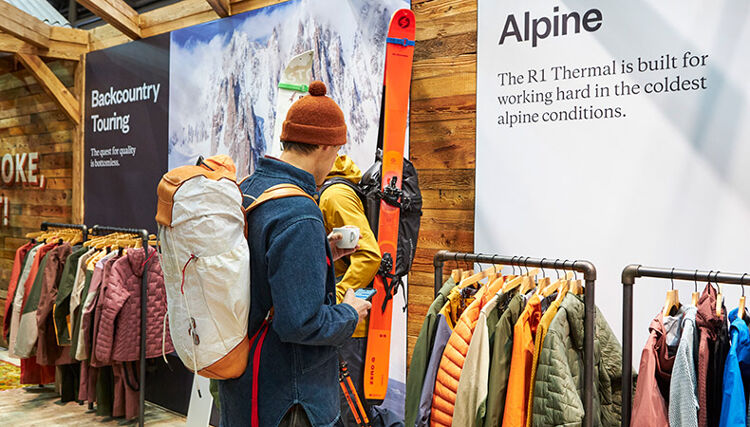The evolution of digital printing and sportswear

Digital printing is a crucial aspect of the production of sportswear. Sonja Angerer shares the importance for printers to be aware of the latest trends in digital printing and sportswear. In the last few years, there has been a true evolution in sportswear.
Off-the-shelf sportswear has been around for over 100 years. So, what is the revolution everyone is talking about? The emergence of COVID-19 is a contributing factor which in turn has strengthened pre-existing trends.
Today, sportswear is not just for the gym or running in the park. Now, people are wearing sportswear whilst working at home, in the office and in their free time. This is due to the fact that sportswear is comfortable, functional, and fashionable. In addition, the pandemic has increased awareness of health and well-being, and many people are more interested in outdoor activities again.
 Caption: Soft colours, such as Pantone's trend shade of 2024, "Peach Fuzz," are now also popular in sportswear. Image credit: Michael Marquandt for Pantone
Caption: Soft colours, such as Pantone's trend shade of 2024, "Peach Fuzz," are now also popular in sportswear. Image credit: Michael Marquandt for Pantone
Current trends in sportswear
The popularity of sportswear is reflected in the new trends of outdoor and hiking clothing. One example is regarding layering, where multiple layers of sportswear are worn on top of each other to adapt to different temperatures and weather conditions. In recent years, soft, easy-to-combine colours have become popular, such as the Pantone Colour of the Year 2024, "Peach Fuzz".
Another term that is often used in this context is "Gorpcore". The word was created back in 2017 and is based on the US word for trail mix, "Good Old Raisins and Peanuts" which is also a popular hiking food in many countries.
“Gorpcore” refers to a style that combines elements of sportswear with outdoor and camping clothing, such as functional jackets, backpacks or hiking boots. The style aims to express a connection to nature while also being practical and stylish.
“Gorpcore” is expected to have a fundamental impact on sportswear in the coming years as more people are interested in outdoor activities. In the meantime, the trend has also arrived in couture fashion. In 2022 and 2023 there were several collaborations between fashion and sports labels, such as MM6 Maison Margiela x Salomon, Off-White x GORE-TEX and North Face x Supreme.
Sustainability is very important in sportswear. Many consumers want their sportswear to be made from environmentally friendly materials, such as recycled polyester or organic cotton. They also prefer sportswear that is durable, easy to care for, and versatile. The industry can save resources and avoid additional waste. Sustainability is not just a trend, but a necessity for the future of sportswear.
 Caption: The boundaries between sportswear and high fashion are becoming increasingly blurred through collaborations and special collections. Image Credit: Messe München
Caption: The boundaries between sportswear and high fashion are becoming increasingly blurred through collaborations and special collections. Image Credit: Messe München
New target markets for sportswear
Sportswear is no longer just for athletes or young people. It appeals to a wide range of audiences that differ in age, taste, culture, and physique. People of all ages can find suitable pieces in the current collections, as they are comfortable, practical, stylish, and durable.
For some time now, major brands such as Nike have also been offering "adaptive fashion", i.e. pieces that people with various disabilities can also wear easily. Almost all manufacturers of sporting goods have also adapted to target groups asking for "Modest Fashion".
Today, Sportswear collections are more adjusted regionally and culturally than in the last decade. As a result, the length of each piece in a collection decreases. Digital printing makes it easy to customise, personalise and optimise sportswear, so it is uniquely suitable for each customer.
One way to create sustainable sportswear is upcycling pre-worn garments. It involves redesigning and upgrading old or damaged textiles, often with the help of digital printing to give them a fresh and individual look.
With digital printing, different patterns, colours, and designs can be applied to the garments without using much water or chemicals. This allows customers to personalise their sportswear according to their own preferences and at the same time help save the planet.
 CAPTION: Many major sportswear brands offer customising certain products, such as shoes. Image Credit: Messe München.
CAPTION: Many major sportswear brands offer customising certain products, such as shoes. Image Credit: Messe München.
Blurring the boundaries between customer and designer
Social media has changed the way sportswear brands interact with their customers. In the past, the brands were the ones that set the trends and created the demand. Today, it is the customers themselves who, as influencers, will create street styles. They share their outfits, their opinions, and their inspirations with millions of followers, becoming authentic brand ambassadors.
This has led sportswear brands to adapt and be more responsive to the needs and desires of their customers. Programs such as "Nike by You" allows them to customise individual shoe models as well as football shirts to create personal one-of-a-kind pieces.
Personalisation platforms such as Spreadshirt, Shirt-King or Shirtlabor have become genuine manufacturers of personal sportswear and leisure wear. With just a few clicks, customers can choose from a variety of raw materials, colours, patterns, and fonts.
Customers can upload their own logos and images or choose from a wide range of designs. Quite often, from small beginnings in self-designed clothing that is given away to friends and relatives, a productive side hustle emerges. Spreadshirt offers everyone the opportunity to sell designs on the platform or even set up their own shop – for free!
Personalised and one-off Sportswear and accessories can only be produced economically with digital textile printing and digital printing. The technologies have contributed to a true revolution in sportswear manufacturing. After all, fashion lovers are no longer forced to only consume. They can live out their creativity and become a sportswear designer themselves.
What does the sportswear revolution mean for printers?
The demand for sportswear has changed significantly in recent years. The pandemic has led to a rise in working from home and online shopping, which, in turn, has increased the demand for comfortable and functional clothing.
At the same time, new target groups for sportswear have emerged, such as older people interested in health and fitness. People with special needs who require customised clothing also expect it from the major sportswear manufacturers. These changes present new challenges and opportunities for production.
On the one hand, manufacturers must respond to customers' increasing demands for quality, comfort, and design. On the other hand, they also must consider the environmental and social impact of their production. New sustainable materials such as recycled plastics or plant-based fibres can help reduce resource consumption and environmental impact, while the trend towards upcycling transforms old clothes into new products. These developments open new opportunities for printers who can enhance sportswear with individual and creative designs.
Interested in joining our community?
Enquire today about joining your local FESPA Association or FESPA Direct
Recent news

GenAI + POD: The Smartest Way to Add Personalised Products to Your Retail Offering in 2025
In 2025, GenAI and POD are transforming retail. Masterpiece AI empowers businesses to offer unique, AI-generated personalised products, from apparel to home decor. Customers use text prompts to create custom designs, streamlining production and boosting sales. This revolutionises customer experience and product offerings.
.png?width=550)
What qualities should visionaries in print have? With Folker Stachetzki from Brother
We speak to Folker Stachetzki, Head of Marketing at Brother about visionaries in print.

Bolstering personalisation by combining print and digital technology
Using printed material in combination with digital technologies offers more opportunities to those offering personalisation to customers. Rob Fletcher shares some recent examples of the print and digital working together to enhance the impact of personalised pieces.

European Sign Expo to highlight developments shaping the future of signage and visual communications
European Sign Expo 2025 (6 – 9 May, Messe Berlin, Germany) is weeks away and a host of leading exhibitors are all set to welcome Visionaries from across the signage and visual communications industries to their stands.